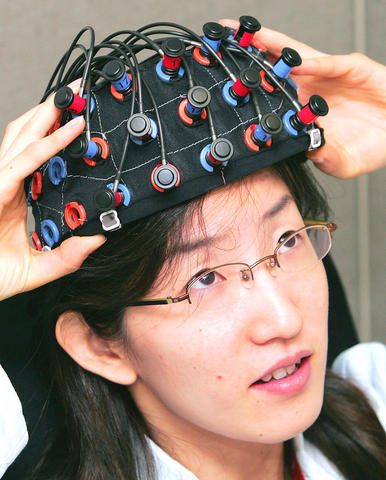Forget the TV remote: A new technology in Japan could let you control electronic devices without lifting a finger simply by reading brain activity.
The "brain-machine interface" developed by Hitachi Inc analyzes slight changes in the brain's blood flow and translates brain motion into electric signals.
A cap connects by optical fibers to a mapping device, which links, in turn, to a toy train set via a control computer and motor during one recent demonstration at Hitachi's Advanced Research Laboratory in Hatoyama, just outside Tokyo.

PHOTO: AP
"Take a deep breath and relax," said Kei Utsugi, a researcher.
At his prompting, I did simple calculations in my head, and the train sprang forward -- apparently indicating activity in the brain's frontal cortex, which handles problem solving.
Activating that region of the brain -- by doing sums or singing a song -- is what makes the train run, according to Utsugi. When I then stopped the calculations, the train stopped, too.
Underlying the brain-machine interface is a technology called optical topography, which sends a small amount of infrared light through the brain's surface to map out changes in blood flow.
Although brain-machine interface technology has traditionally focused on medical uses, makers like Hitachi and Japanese automaker Honda Motor Co have been racing to refine the technology for commercial application.
Hitachi's scientists are set to develop a brain TV remote controller letting users turn a TV on and off or switch channels by only thinking.
Honda, whose interface monitors the brain with a magnetic resonance imaging (MRI) machine like those used in hospitals, is keen to apply the interface to intelligent, next-generation automobiles.
The technology could one day replace remote controls and keyboards and perhaps help disabled people operate electric wheelchairs, beds or artificial limbs.
Initial uses would be helping people with paralyzing diseases communicate even after they have lost all control of their muscles.
Since 2005, Hitachi has sold a device based on optical topography that monitors brain activity in paralyzed patients so they can answer simple questions -- for example, by doing mental calculations to indicate "yes" or thinking of nothing in particular to indicate "no."
"We are thinking various kinds of applications," project leader Hideaki Koizumi said. "Locked-in patients can speak to other people by using this kind of brain machine interface."
A key advantage to Hitachi's technology is that sensors don't have to physically enter the brain. Earlier technologies developed by US companies like Neural Signals Inc required implanting a chip under the skull.
Still, major stumbling blocks remain.
Size is one issue, though Hitachi has developed a prototype compact headband and mapping machine that together weigh only about 1kg.
Another would be to tweak the interface to more accurately pick up on the correct signals while ignoring background brain activity.
Any brain-machine interface device for widespread use would be "a little further down the road," Koizumi said.
He added, however, that the technology is entertaining in itself and could easily be applied to toys.
"It's really fun to move a model train just by thinking," he said.

People can preregister to receive their NT$10,000 (US$325) cash distributed from the central government on Nov. 5 after President William Lai (賴清德) yesterday signed the Special Budget for Strengthening Economic, Social and National Security Resilience, the Executive Yuan told a news conference last night. The special budget, passed by the Legislative Yuan on Friday last week with a cash handout budget of NT$236 billion, was officially submitted to the Executive Yuan and the Presidential Office yesterday afternoon. People can register through the official Web site at https://10000.gov.tw to have the funds deposited into their bank accounts, withdraw the funds at automated teller

PEACE AND STABILITY: Maintaining the cross-strait ‘status quo’ has long been the government’s position, the Ministry of Foreign Affairs said Taiwan is committed to maintaining the cross-strait “status quo” and seeks no escalation of tensions, the Ministry of Foreign Affairs (MOFA) said yesterday, rebutting a Time magazine opinion piece that described President William Lai (賴清德) as a “reckless leader.” The article, titled “The US Must Beware of Taiwan’s Reckless Leader,” was written by Lyle Goldstein, director of the Asia Program at the Washington-based Defense Priorities think tank. Goldstein wrote that Taiwan is “the world’s most dangerous flashpoint” amid ongoing conflicts in the Middle East and Russia’s invasion of Ukraine. He said that the situation in the Taiwan Strait has become less stable

CONCESSION: A Shin Kong official said that the firm was ‘willing to contribute’ to the nation, as the move would enable Nvidia Crop to build its headquarters in Taiwan Shin Kong Life Insurance Co (新光人壽) yesterday said it would relinquish land-use rights, or known as surface rights, for two plots in Taipei’s Beitou District (北投), paving the way for Nvidia Corp to expand its office footprint in Taiwan. The insurer said it made the decision “in the interest of the nation’s greater good” and would not seek compensation from taxpayers for potential future losses, calling the move a gesture to resolve a months-long impasse among the insurer, the Taipei City Government and the US chip giant. “The decision was made on the condition that the Taipei City Government reimburses the related

FRESH LOOK: A committee would gather expert and public input on the themes and visual motifs that would appear on the notes, the central bank governor said The central bank has launched a comprehensive redesign of New Taiwan dollar banknotes to enhance anti-counterfeiting measures, improve accessibility and align the bills with global sustainability standards, Governor Yang Chin-long (楊金龍) told a meeting of the legislature’s Finance Committee yesterday. The overhaul would affect all five denominations — NT$100, NT$200, NT$500, NT$1,000 and NT$2,000 notes — but not coins, Yang said. It would be the first major update to the banknotes in 24 years, as the current series, introduced in 2001, has remained in circulation amid rapid advances in printing technology and security standards. “Updating the notes is essential to safeguard the integrity